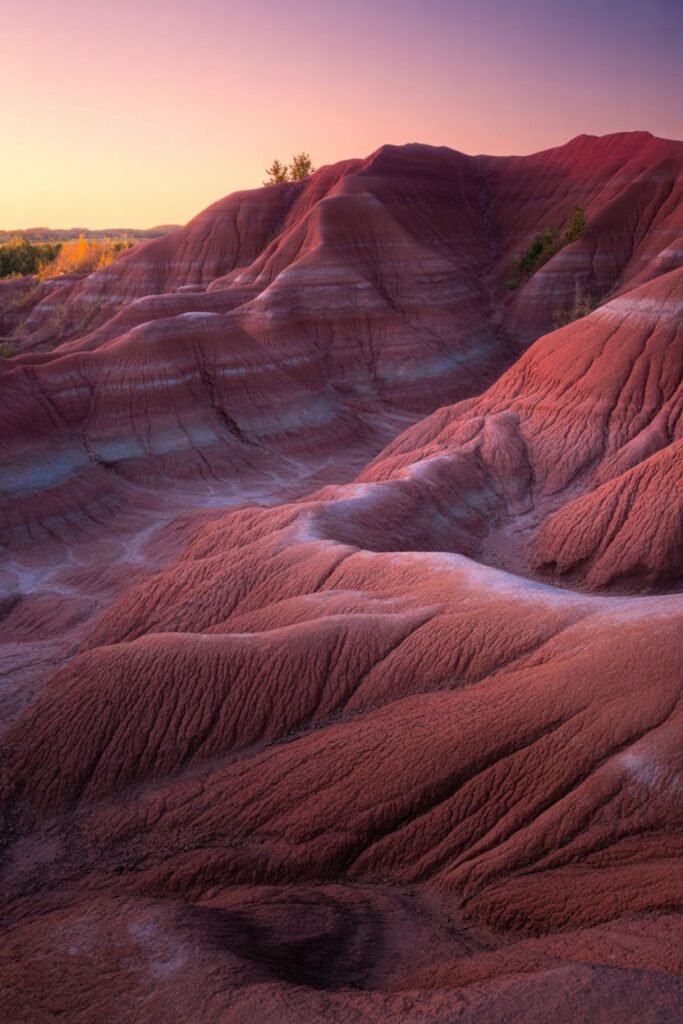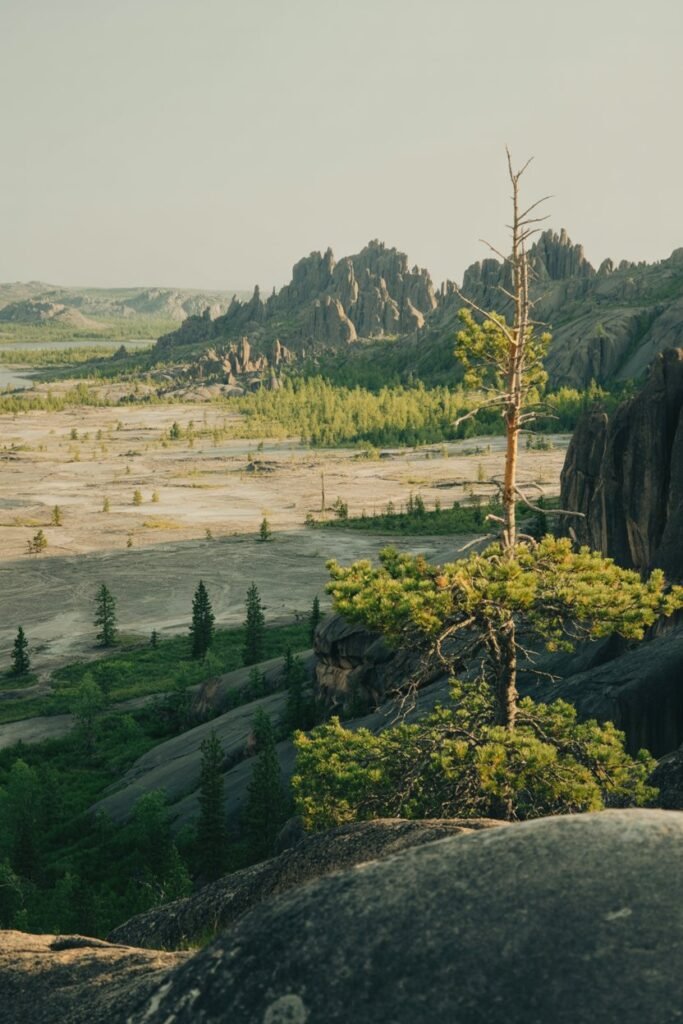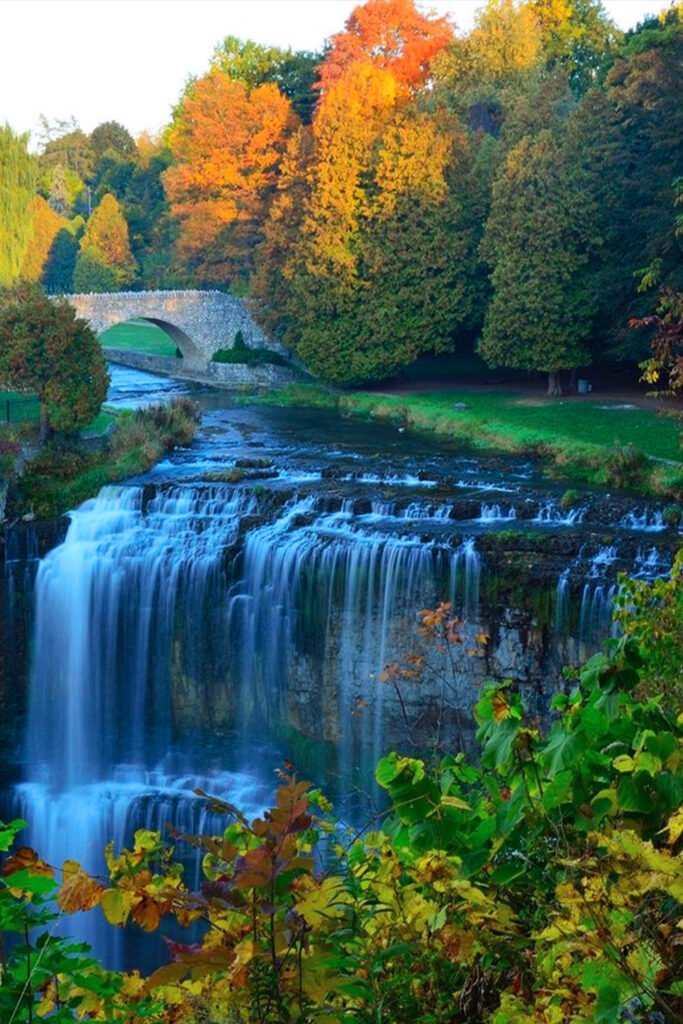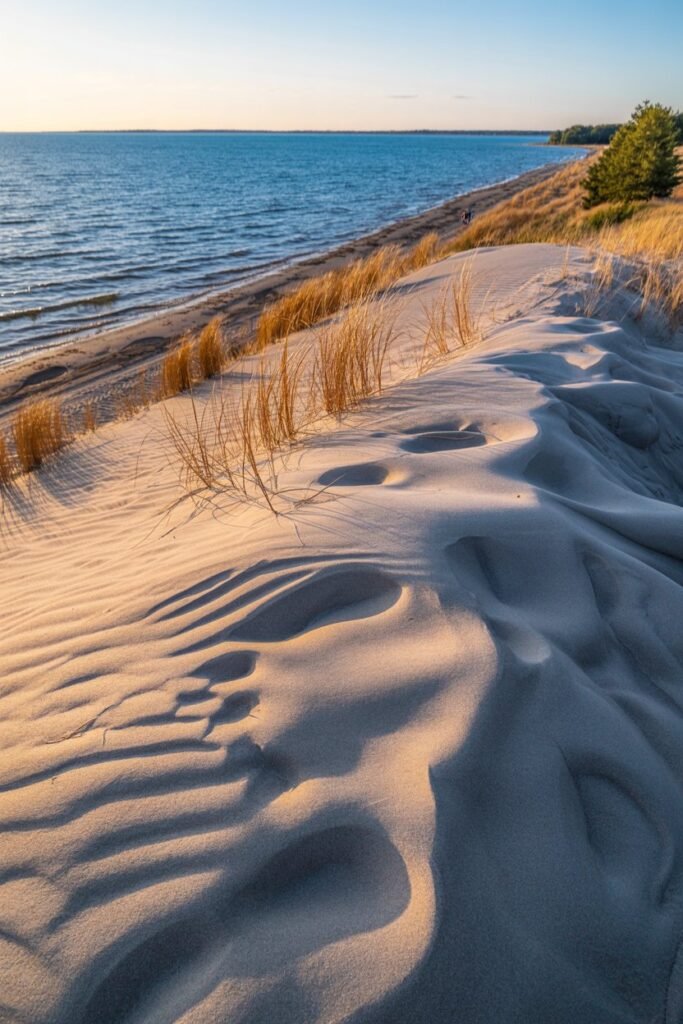Estimated reading time: 20 minutes
Last Modified Date: Oct. 01, 2025
Key Takeaways
- The Cheltenham Badlands feature unique Mars-like red hills formed throScarborough Bluffs rise dramatically along Lake Ontariough erosion and historical farming practices, offering photographers stunning landscapes.
- Scarborough Bluffs rise dramatically along Lake Ontario, with hiking trails that showcase layered sand and clay formations shaped by glacial activity.
- The Sudbury Basin is the third-largest known meteorite impact crater on Earth, formed 1.8 billion years ago and responsible for the region’s rich mineral deposits.
- The Niagara Escarpment, a UNESCO World Biosphere Reserve, stretches over 725 kilometers with dramatic limestone ridges, lush forests, and numerous waterfalls.
- Prince Edward County is home to the world’s largest freshwater sand dune system at Sandbanks Provincial Park, offering a unique coastal experience in Ontario.
Table of Contents
- Introduction
- Visiting the Cheltenham Badlands
- Hiking the Scarborough Bluffs
- Sudbury Basin Meteorite Crater Explained
- Exploring the Niagara Escarpment
- Prince Edward County Sand Dunes
- Frequently Asked Questions about Unique Geological Formations in Ontario
- Conclusion
Introduction
Beyond the iconic skyline of Toronto and the thundering waters of Niagara Falls lies a hidden side of Ontario that few travelers fully discover. The province harbors extraordinary natural wonders that showcase its geological diversity and breathtaking landscapes. From otherworldly terrains to towering cliffs, these hidden gems of Ontario offer unique experiences for those willing to venture off the beaten path.
In this article, we’ll explore five remarkable natural attractions that showcase Ontario’s geological marvels: the Mars-like terrain when visiting the Cheltenham Badlands, the dramatic experience of hiking the Scarborough Bluffs, the ancient story behind the Sudbury Basin meteorite crater, the diverse landscapes while exploring the Niagara Escarpment, and the surprising coastal beauty of Prince Edward County sand dunes.
These destinations appeal to nature enthusiasts, photographers, geology buffs, and travelers seeking authentic experiences away from the typical tourist routes. Whether you’re planning a dedicated trip to these sites or looking to add them to your Ontario itinerary, this guide provides practical information to help you make the most of your visit to these natural wonders.
Want to watch the Wonders of Ontario Travel Documentary in UHD 4K Resolution? Click here to watch on YouTube.
Visiting the Cheltenham Badlands
Just northwest of Toronto’s urban sprawl lies one of Ontario’s most unusual landscapes. The Cheltenham Badlands present visitors with a surreal terrain that seems transplanted from another planet. Spanning 36 acres, these striking red hills with their sharp ridges and deep gullies create a dramatic contrast to Ontario’s typically verdant scenery.
The landscape is composed of Queenston shale, a soft red bedrock that gives the badlands their distinctive Mars-like appearance. The vibrant reddish hue comes from iron oxide deposits within the rock, which glow dramatically when lit by the late afternoon sun. What makes these formations particularly fascinating is their relatively recent exposure in geological terms.

Geological Formation and History of the Cheltenham Badlands
Unlike most geological wonders that form over millions of years, the Cheltenham Badlands were revealed through human activity. In the 1930s, poor farming practices led to severe soil erosion that stripped away the protective vegetation and topsoil. This agricultural mistake exposed the underlying Queenston shale to the elements [SOURCE]. Once exposed, natural erosion from rain and runoff quickly carved the distinctive patterns we see today.
The badlands sit within the larger Caledon region where the Niagara Escarpment creates a varied landscape of hills and valleys. The nearby Credit River runs through this terrain, supporting diverse ecosystems that stand in stark contrast to the barren badlands.
Best Photography Tips for Visiting the Cheltenham Badlands
For photographers, the badlands offer exceptional opportunities throughout the day, but certain times yield more dramatic results:
- Golden hour (one hour before sunset) provides the most striking light, when the low sun angle intensifies the red coloration and creates defining shadows across the rippled terrain.
- Early morning offers soft light with fewer visitors, perfect for unobstructed landscape shots.
- After rainfall, the wet surface deepens the red color, creating more saturated images.
The site features a wooden observation deck that provides excellent vantage points without damaging the fragile terrain. From this platform, visitors can appreciate the full scope of the undulating patterns below.
Visitor Information for the Cheltenham Badlands in Ontario
When planning your visit, keep these important details in mind:
- Walking directly on the badlands is strictly prohibited to prevent further erosion and preserve the site for future generations.
- The site is managed by Credit Valley Conservation, and staff are often present to answer questions about the geological features.
- A dedicated parking lot is available with daily fees ($10-$20 depending on season).
- The site is typically open from April through October, weather permitting.
- Basic amenities include portable restrooms and informational signage.
- The Bruce Trail, Ontario’s oldest and longest marked hiking trail, passes near the badlands and offers additional exploration opportunities.
The closest town is Caledon, where you can find restaurants, accommodations, and supplies before or after your visit to the badlands. For those interested in exploring more hidden gems in Canada, this area makes an excellent starting point.
Hiking the Scarborough Bluffs: Trails, Safety, and Seasonal Views
Rising dramatically along Lake Ontario’s shoreline, the Scarborough Bluffs form one of the most spectacular natural features in the Toronto region. These imposing clay cliffs stretch for about 15 kilometers and reach heights of up to 90 meters (300 feet) above the lake, creating an unexpected coastal landscape within Canada’s largest city.
Geological Significance of the Scarborough Bluffs
The bluffs showcase layers of sand and clay that tell a fascinating geological story. These sediments were deposited during the last ice age, approximately 12,000 years ago, when glaciers advanced and retreated across the region [SOURCE]. The distinctive stratification visible in the cliff face reveals this ancient process, with each horizontal layer representing different periods of glacial activity.
Today, these formations continue to evolve through natural erosion. The bluffs recede at an average rate of about 30 centimeters per year as waves from Lake Ontario undercut the base of the cliffs. This ongoing process means the landscape is constantly changing, with occasional small landslides reshaping sections of the bluffs.
Hiking the Scarborough Bluffs: Trails and Scenic Viewpoints
Several parks along the bluffs offer different perspectives and hiking experiences:
- Bluffer’s Park provides the most accessible view of the bluffs from below. A flat, paved path follows the shoreline with magnificent views of the towering cliffs.
- Scarborough Crescent Park offers views from atop the bluffs with several lookout points.
- Guild Park and Gardens combines art, history, and nature with trails leading to bluff overlooks.
- The Scarborough Bluffs Trail connects several of these parks, though sections may be closed due to erosion concerns.

For the best hiking experience, start at Bluffer’s Park and walk eastward along the beach. As you progress, the bluffs become increasingly dramatic, with their sheer faces towering overhead. This route allows you to appreciate both the scale of the cliffs and the beautiful sandy beach below.
Safety Tips for Hiking the Scarborough Bluffs
Hiking the Scarborough Bluffs requires some careful planning and awareness:
- Stay on designated trails and observe all warning signs. The edge of the bluffs can be unstable and dangerous.
- Never climb the face of the bluffs, as they are composed of loose material prone to sudden collapse.
- Check weather conditions before visiting, as trails can become muddy and hazardous after rainfall.
- Wear proper footwear with good traction, especially when hiking the steeper sections.
- The most spectacular views typically occur in late afternoon when the western sun illuminates the eastern face of the bluffs.
Facilities vary between the different parks, but most have parking (which fills quickly on summer weekends), restrooms, and picnic areas. Bluffer’s Park also features a marina, restaurant, and a Blue Flag certified beach for swimming.
For those interested in photography, the contrast between the white cliffs, blue lake, and green vegetation creates stunning compositions, particularly from the beach level looking upward or from designated lookout points along the top.
Sudbury Basin Meteorite Crater Explained: Impact, Mining, and Visitor Guide
In Northern Ontario lies an extraordinary geological feature that’s easily overlooked because of its massive scale. The Sudbury Basin is the third-largest known impact crater on Earth, stretching approximately 60 kilometers long and 30 kilometers wide. Unlike many famous craters that form obvious depressions in the landscape, the Sudbury Basin’s ancient origins require some understanding to fully appreciate its significance.
Sudbury Basin Meteorite Impact and its Geological Significance
Approximately 1.85 billion years ago, a meteorite estimated to be 10-15 kilometers in diameter slammed into Earth at this location [SOURCE]. The impact was so powerful that it created an initial crater about 250 kilometers wide. To put this in perspective, the energy released would have been millions of times greater than the most powerful nuclear weapon ever detonated.
The collision melted and fractured the Earth’s crust, creating a basin that gradually filled with sediment over millions of years. The extreme heat and pressure from the impact also triggered unique geological processes that would later shape the region’s economic future.
Sudbury Basin: Mining History and Economic Impact
The Sudbury Basin owes its industrial importance directly to this ancient cosmic collision. The meteorite impact concentrated valuable metals including nickel, copper, platinum, palladium, gold, and other precious elements in the region.
When mining began in the area in the late 19th century, no one understood the basin’s meteorite origins. It wasn’t until the 1960s that scientists recognized the distinctive shock features in the rock that confirmed the impact theory. Today, Sudbury remains one of the world’s most important mining regions, with operations that have extracted billions of dollars worth of minerals from the crater.
This cosmic gift came with environmental consequences, however. Decades of mining and smelting activities severely damaged the local ecosystem, creating a barren landscape often compared to the surface of the moon.

Sudbury Basin: Environmental Recovery After Mining
Since the 1970s, Sudbury has undertaken one of the world’s most successful environmental recovery programs. The city and mining companies have:
- Planted more than 10 million trees to reforest the damaged landscape
- Neutralized acidified soil with limestone applications
- Dramatically reduced smelter emissions
- Restored lakes and waterways affected by acid rain
The results have been remarkable, with lush vegetation returning to areas that were once barren rock. Wildlife has also returned to the region, making Sudbury a model for industrial environmental rehabilitation.
Visitor Guide to Exploring the Sudbury Basin Crater
While the basin itself is too large to view in its entirety from ground level, visitors can learn about this remarkable feature at Science North, Sudbury’s science center. Interactive exhibits explain the impact event and its geological significance.
The Dynamic Earth museum, built near an active mine, offers underground tours and extensive exhibits on mining and geology. Here, visitors can hold rocks containing shatter cones – distinctive fracture patterns that provide key evidence of the meteorite impact.
For those wanting to experience the basin landscape, numerous lookout points around Sudbury offer views across portions of this enormous geological feature. Ramsey Lake, located right in the city, sits within the basin and provides a pleasant setting to contemplate the cosmic event that shaped this region billions of years ago.
Hikers can explore sections of the basin rim on trails near Manitoulin Island, offering both geological interest and scenic views of the surrounding landscape.
Exploring the Niagara Escarpment: Waterfalls, Trails, and Ecology
The Niagara Escarpment is far more than just the cliff that creates Niagara Falls. This massive limestone ridge stretches over 725 kilometers across Ontario, forming one of the most significant geographical features in the province. Designated as a UNESCO World Biosphere Reserve in 1990, the escarpment represents a remarkable blend of natural history, biodiversity, and scenic beauty.
Exploring the Geological Significance of the Niagara Escarpment
The escarpment began forming over 450 million years ago during the Silurian period when this region was covered by a shallow tropical sea. Sediments from marine organisms gradually accumulated on the sea floor, eventually forming the dolostone and limestone that compose much of the escarpment today [SOURCE].
As the ancient sea retreated and the continent underwent geological uplift, erosion carved away softer rocks while leaving the resistant dolostone cap rock intact. This differential erosion created the distinctive cliff face or “escarpment” that defines this feature.
Today, the escarpment creates dramatic elevation changes throughout southern Ontario, with vertical cliffs rising up to 335 meters above the surrounding landscape at their highest points. These cliffs provide both scenic vistas and unique microclimates that support specialized plant communities.
Waterfalls and Unique Natural Features of the Niagara Escarpment
While Niagara Falls is the most famous waterfall along the escarpment, the geological formation creates numerous other cascades throughout its length. The Hamilton area alone boasts more than 100 waterfalls where streams cross the escarpment’s edge, earning it the nickname “Waterfall Capital of the World.”

Notable waterfalls include:
- Webster’s Falls in Spencer Gorge, featuring a classic 22-meter curtain waterfall
- Tew’s Falls, one of the tallest in the region at 41 meters
- Albion Falls, a complex terraced cascade that’s particularly photogenic
- Devil’s Punchbowl, with its distinctive ribbon of water falling 37 meters into a bowl-shaped gorge
Beyond waterfalls, the escarpment features numerous caves, crevices, and unique rock formations. The most famous is the Lion’s Head formation on the Bruce Peninsula, which resembles a lion’s profile when viewed from Georgian Bay.
Hiking the Bruce Trail: Best Sections on the Niagara Escarpment
The escarpment serves as the backbone for Canada’s oldest and longest marked footpath, the Bruce Trail. This 900-kilometer trail follows the escarpment from Niagara to Tobermory at the tip of the Bruce Peninsula, offering hikers access to some of Ontario’s most spectacular landscapes.
Some of the most rewarding sections include:
- Rattlesnake Point in Milton, featuring ancient cedar trees growing directly from cliff faces and panoramic views of the countryside
- Lion’s Head Provincial Park, where the trail follows the escarpment edge with breathtaking views over Georgian Bay
- Niagara Glen, where hikers can descend into a pristine gorge filled with huge boulders and rare Carolinian forest
- Spencer Gorge, combining multiple waterfalls with outstanding vistas
The trail system is well-maintained by the Bruce Trail Conservancy and includes both challenging sections for experienced hikers and gentler routes suitable for casual day hikes.
Biodiversity and Ecology Along the Niagara Escarpment
The escarpment creates diverse habitats that support an extraordinary range of plant and animal species. Its various microclimates harbor over 300 bird species, 55 mammal species, 36 reptile and amphibian species, and more than 1,500 plant species.
Of particular ecological importance are the ancient cedar trees growing from the escarpment cliffs. Some of these trees are over 1,000 years old, making them among the oldest living organisms in eastern North America. These gnarled, stunted trees survive in almost impossible conditions, rooted in tiny cracks in vertical cliff faces.
The escarpment also protects remnants of the Carolinian forest, a rare ecosystem in Canada that contains species typically found much further south. This forest type harbors the highest biodiversity in Canada, including many species at risk.
For those interested in experiencing other historic waterways in Ontario, the Rideau Canal provides another unique experience, especially in winter when it transforms into the world’s largest skating rink.
Prince Edward County Sand Dunes: Sandbanks Provincial Park Travel Guide
In stark contrast to Ontario’s predominantly rocky and forested landscapes stands a coastal paradise that seems transported from a more tropical setting. Prince Edward County, a peninsula that juts into Lake Ontario, hosts one of the province’s most unexpected natural attractions: an extensive system of freshwater sand dunes that rivals coastal formations found along ocean shores.

Discover Sandbanks Provincial Park and its Sand Dunes
The crown jewel of this dune system is Sandbanks Provincial Park, home to the world’s largest freshwater baymouth barrier dune formation [SOURCE]. Here, golden sand dunes tower up to 25 meters (80 feet) high, creating a stunning visual contrast against the blue waters of Lake Ontario.
These dunes began forming approximately 12,500 years ago as the glaciers retreated, leaving behind massive quantities of sand and gravel. Wave action along the shoreline gradually shaped these deposits into the distinctive dune formations visible today. Strong prevailing winds from the southwest continue to sculpt and reshape these dunes, making them a dynamic, ever-changing landscape.
The park encompasses three main beach areas, each with its own unique character:
- Dunes Beach features the most impressive sand dunes, with rolling hills of sand extending inland from the shoreline.
- Outlet Beach offers a more sheltered swimming area and gentler dunes.
- Sandbanks Beach stretches for kilometers along West Lake, providing plenty of space even on busy summer days.
Ecological Importance of Prince Edward County Sand Dunes
Beyond their scenic beauty, these dunes support unique ecological communities adapted to the challenging conditions of shifting sand and limited water. The dune environment transitions through several distinct zones, from the active beach to the established dune forests further inland.
Specialized plants like marram grass play a crucial role in stabilizing the dunes with their extensive root systems. This pioneering species can withstand burial in sand and thrives in the harsh, exposed environment of active dunes. As you move away from the shoreline, the vegetation becomes increasingly diverse and eventually transitions to woodland.
The dune system also provides important habitat for birds, including the endangered Piping Plover which occasionally nests on the beaches. Migratory birds use these shorelines as resting areas during their seasonal journeys.
Fun Recreational Activities at Prince Edward County Sand Dunes
The dunes and adjacent beaches offer numerous recreational opportunities throughout the year:
- Swimming in the warm, shallow waters of Lake Ontario (typically comfortable from late June through early September)
- Sunbathing on some of Ontario’s finest sandy beaches
- Photography, especially during golden hour when the low angle of sunlight creates dramatic shadows across the dune ridges
- Hiking on designated trails through the dune environments and adjacent wetlands
- Birdwatching, particularly during spring and fall migrations
- Canoeing and kayaking in the protected waters of West Lake
Practical Visiting Tips for Prince Edward County Sand Dunes
If you’re planning to experience the Prince Edward County sand dunes, keep these tips in mind:
- The park can reach capacity during summer weekends, particularly in July and August. Arrive early or visit mid-week if possible.
- The optimal times to visit are late spring (June) and early fall (September), when the weather remains pleasant but crowds are significantly smaller.
- Day-use fees apply for park entry, with seasonal passes available for frequent visitors.
- Camping is available within the park, but sites must be reserved well in advance (up to 5 months for summer weekends).
- Stay on designated paths through the dunes to protect the fragile vegetation that stabilizes the sand.
- Bring sun protection, as there is limited natural shade on the beaches and dunes.
The surrounding Prince Edward County region offers additional attractions, including wineries, farm-to-table restaurants, and artisan shops, making it an ideal destination for a weekend getaway or longer vacation. The county’s relaxed pace and rural character provide a perfect complement to days spent exploring its unique coastal landscapes.
Many visitors combine their dune exploration with visits to nearby Kingston, which offers historical attractions and a vibrant downtown area just an hour’s drive away.
Frequently Asked Questions about Unique Geological Formations in Ontario
When is the best season to visit Ontario’s geological formations for hiking and photography?
The most favorable months are late spring (May–June) and early fall (September–October), when hiking trails and photography conditions are at their best. Crowds are lighter than midsummer, and lighting at sites like the Cheltenham Badlands or Scarborough Bluffs is particularly striking in early morning or late afternoon.
Are Ontario’s geological sites safe for hiking and day trips?
Most sites are safe for hiking and day trips when visitors follow posted guidelines and local conservation rules. For example, walking on the Cheltenham Badlands is prohibited, and staying on designated paths at the Scarborough Bluffs is important due to erosion and unstable edges.
What are the typical costs and fees for exploring Ontario’s natural wonders?
Costs vary depending on the location. Sites like Cheltenham Badlands and Sandbanks Provincial Park require day-use or parking fees, while many trails along the Niagara Escarpment and parts of the Sudbury Basin are free to access. Museums such as Dynamic Earth in Sudbury charge admission, making budgeting dependent on the mix of stops.
What should I pack when visiting Ontario’s geological formations and trails?
Pack sturdy walking shoes, water, and weather-appropriate clothing for trails, plus sun protection for open dune areas. A tripod is useful for photography at the Sudbury Basin or Cheltenham Badlands, while maps, insect repellent, and snacks are helpful for longer sections of the Niagara Escarpment.
How can travelers plan an itinerary that combines multiple geological sites in Ontario?
Many formations are within driving distance of each other, making it easy to create a regional itinerary linking hikes, scenic drives, and nearby towns. A trip might include hiking the Scarborough Bluffs in Toronto, visiting the Cheltenham Badlands northwest of the city, and continuing toward Prince Edward County or Sudbury for multi-day exploration.
Conclusion
Ontario’s geological formations highlight the province’s diverse landscapes and deep natural history. From the rust-red shale of the Cheltenham Badlands to the sheer cliffs of the Scarborough Bluffs, each site reflects the combined forces of erosion, glaciation, or cosmic impact. The Sudbury Basin reveals how ancient collisions shaped today’s economy, while the Niagara Escarpment and its trails show the enduring legacy of ancient seas. Prince Edward County adds a coastal dimension with its shifting dune systems along Lake Ontario.
These sites complement each other within a compact travel area, allowing visitors to experience a wide range of geological stories in one province. They also connect naturally with broader itineraries, whether linking the escarpment with Ontario waterfalls or pairing the dunes with cultural stops in nearby Kingston.
Exploring these natural landmarks requires planning around access rules, conservation practices, and seasonal conditions, but the effort brings a deeper appreciation of Ontario’s landscapes. For travelers designing extended trips, combining these destinations with other provincial highlights—such as Ontario’s historic waterways—creates a well-rounded view of the region’s natural and cultural heritage.
Approached with respect and curiosity, these wonders offer not just scenic beauty but a meaningful connection to the forces that continue to shape Ontario’s environment.
For more stunning views of these natural wonders and other spectacular locations around the world, be sure to visit Pathfinders Travel on YouTube, where you can watch travel documentaries featuring Ontario and other destinations in stunning 4K resolution.




